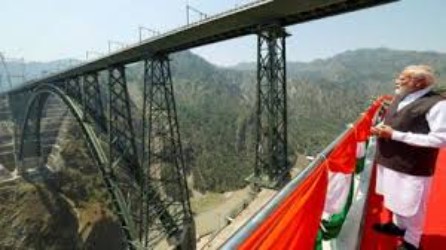On June 6, 2025, Prime Minister Narendra Modi inaugurated the Chenab Rail Bridge in Reasi district, Jammu and Kashmir, marking a monumental achievement in India’s infrastructure development. Standing at 359 meters above the Chenab River, the bridge surpasses the Eiffel Tower by 35 meters, earning it the title of the world’s highest railway arch bridge.
Part of the Udhampur-Srinagar-Baramulla Rail Link (USBRL) project, the Chenab Bridge spans 1,315 meters and is designed to withstand extreme conditions, including seismic activity and high-velocity winds up to 260 km/h. Constructed with 30,000 tonnes of steel, the bridge is built to last 120 years and features a blast protection platform—a first in India’s rail sector—to enhance safety.
It is now officially the tallest railway bridge in the world, symbolizing engineering excellence and strategic connectivity.
ABOUT CHENAB RAILWAY BRIDGE:
This is a steel arch railway bridge constructed over the Chenab River in Jammu & Kashmir. It holds the distinction of being the world’s tallest railway bridge, rising to a height of 359 meters—which is 35 meters taller than the Eiffel Tower.
The bridge is located between Bakkal and Kauri villages in the Reasi district of Jammu & Kashmir. It is a crucial part of the Udhampur–Srinagar–Baramulla Rail Link (USBRL) project, connecting Katra to Sangaldan and paving the way for direct rail connectivity to Srinagar.
The project was executed by Konkan Railway Corporation and constructed by a joint venture comprising Afcons Infrastructure, Ultra Construction (South Korea), and VSL India.
Key Features:
- Total Length: 1,315 meters (530 m approach + 785 m main arch)
- Wind Resistance: Withstands wind speeds up to 266 km/h
- Earthquake Resistance: Built to endure quakes up to magnitude 8
- Temperature Tolerance: Operates in conditions as low as –20°C
- Blast-Proof Design: Can withstand blasts equivalent to 40 tonnes of TNT
- Lifespan: 120 years
- Train Speed: Trains can travel at speeds up to 100 km/h
Why It Matters:
- Strategic Value: Enhances connectivity to the sensitive border region of Kashmir
- Engineering Marvel: Constructed in a geologically complex, high seismic zone (Zone V)
- National Integration: Ensures uninterrupted railway access to the Kashmir Valley
- Civil Engineering Icon: A symbol of India’s infrastructure progress and resilience
- Regional Impact: Expected to boost tourism, economic growth, and employment opportunities
The inauguration of the bridge is a testament to India’s commitment to enhancing connectivity in Jammu and Kashmir, a region historically challenged by geographical and political barriers. PM Modi hailed the bridge as a symbol of national unity and resilience, especially in the wake of recent conflicts.
With the bridge now operational, the USBRL project is set to revolutionize travel between Katra and Srinagar, reducing journey times significantly. The introduction of Vande Bharat Express trains is expected to further enhance connectivity, fostering greater integration of Jammu and Kashmir with the rest of India.
The Chenab Rail Bridge stands as a testament to India’s engineering excellence and unwavering resolve to overcome challenges, paving the way for a more connected and prosperous future.



